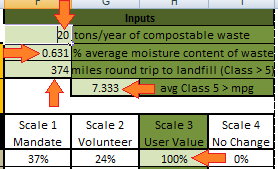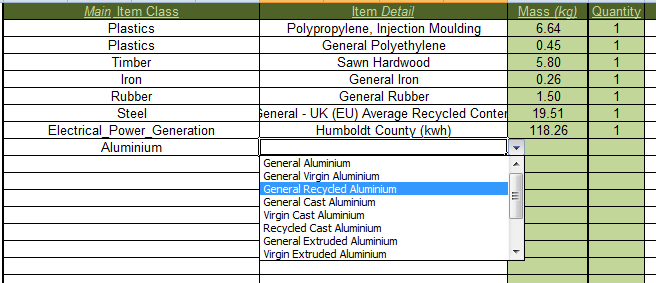Waste Stream Analysis & Life Cycle Analysis Table
This workbook facilitates the comparison of various diversion scenarios on 4 tabs Scope, Method 1, Method 2, Results.
File:WasteDiversionAutomatedICEtable.xls
Determining Current Impacts
Using business as usual information, this tab determines the scale of current energy and carbon impacts and the potential of diverting waste to an anaerobic digester.

Use the mouse to select the cells shown in Figure 1 to enter the following information:
- Total Waste Stream Volume in Standard Tons
- Average Moisture content of Waste Stream
- Current Distance to Landfill
- Fuel Efficiency of the Class 5 (or greater) Transportation Vehicle
- Diversion Percentage
Calculating Impacts of Diversion Methods
Diverting waste requires varying amounts of energy based on the method by which waste is diverted. Use these tabs to enter the resources consumed to divert the waste.

- Select the type of material from the drop down list in the first column. If the material can not be found and the energy and carbon emission information is known, enter the main item description in the Manual Entry Fields.
- Select the appropriate Item Detail from the drop down list in the second column. If manual entry, enter some detail about the resource.
- Enter the mass of the material in kilograms in the third column.
- Finally enter the number of items required to divert the amount of waste based on scale.
Note: To facilitate this process the ICE Summary Table is available.
Results
This allows a glance comparison of the energy and emissions associated with the various scales and alternatives, including net changes compared to business as usual.
HSU Scenario w/ Results
Land-filled waste emits Greenhouse Gases (GHGs) and transporting waste to a landfill consumes considerable energy. In 2000, Humboldt County’s landfill was capped and closed; consequently, 17 tons of paper towel landfill-bound waste is trucked an average of 187 miles (374 miles round trip) to either the Dry Creek Landfill in White City, Oregon or the Anderson Landfill outside of Redding, California. If Humboldt State University (HSU) were to divert paper towel waste to Humboldt Waste Management Authority’s (HWMA) proposed anaerobic biodigester, the amount of energy generated from that paper towel waste would help offset the energy consumed in transporting the remaining landfill waste.
Alternative methods included local truck or electric cart collection and consolidation with both requiring minor resources for pre-processing at HSU.